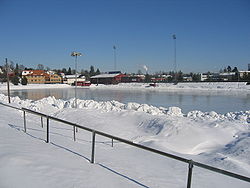

The 1952 Winter Olympics were held in and around Oslo, Norway, from 14 to 25 February 1952. Ten competition and eight non-competition venues were used, in addition to three designated, but unused, reserve competition venues. Six of the competition venues were located in Oslo, while one each was located in Bærum, Skedsmo, Drammen and Krødsherad. Bislett stadion was the centerpiece of the games, hosting the opening and closing ceremonies, the speed skating and the figure skating. Bislett featured both a 400-meter (1,300 ft) circumference speed skating track and a 60-meter (200 ft) long rink used for figure skating, separated by snow banks. [1] Two reserve venues were designated for the skating events, Tryvann stadion in Oslo and Hamar stadion in Hamar. [2]
Contents
Jordal Amfi, an outdoor artificial ice rink, [3] was built with a capacity for 10,000 spectators. [4] This allowed ice hockey to be played on artificial ice for the first time at the Olympics. [5] [6] Of the tournament's 36 matches, 23 were played at Jordal, while the remaining were played at Kadettangen in Bærum, Dælenenga idrettspark in Oslo, Lillestrøm stadion in Skedsmo and Marienlyst stadion in Drammen. [2]
The ski jumping, cross-country skiing and Nordic combined events were held at Holmenkollbakken, 8 kilometers (5 mi) from the city center. [7] Although upgraded several times since its opening in 1892, the former wooden superstructure was replaced with a concrete tower and in-run ahead of the Olympics, with the out-run being extended to 87 meters (285 ft). [8] Stands were erected to seat 13,000 people, with capacity for an additional 130,000 standing spectators at the base of the hill. [9] Cross-country races started and ended at the base of the ski hill. [10] A switchboard was posted at the start and finish lines to help spectators monitor the progress of the competitors during the races. [11] Most of the stands built for the ski jumping competition had to be removed for the cross-country races. As a result, there was little room for spectators to sit and watch the cross-country events. Spectators were therefore allowed to walk within the course. [10]
The alpine skiing events were split between Rødkleiva, located in Oslo near Holmenkollen, and Norefjell, located at Krødsherad, 113 kilometers (70 mi) from Oslo and the only venue outside Greater Oslo. [12] Rødkleiva featured the slalom events, with an elevation difference on the hill of 200 meters (660 ft) and a course length of 480 meters (1,570 ft). [13] Downhill and giant slalom, the latter of which was making its Olympic debut, were competed at Norefjell. [12] Considerable construction and upgrades were made to the area to make it suitable for Olympic competition. A bridge was built across the lake of Krøderen to help with transportation concerns; a new hotel, two ski lifts, and a new road were also constructed. [13]
There was no permanent bobsleigh run in Norway as there was very little interest in the sport. [14] The organizers decided to build a temporary course, Korketrekkeren, out of snow, [15] which ran down the hill from Frognerseteren, near Holmenkollen. The course was 1,508 meters (4,948 ft) long and featured 13 turns. [16] The run was built and tested in 1951, and was rebuilt in 1952 in time for the Olympics. [15]


